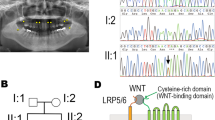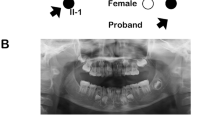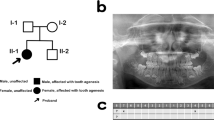Abstract
Congenital tooth agenesis is a common anomaly in human development. We performed exome sequence analysis of genomic DNA collected from Japanese patients with tooth agenesis and their relatives. We found a novel single-nucleotide insertion in the LRP6 gene, the product of which is involved in Wnt/β-catenin signaling as a coreceptor for Wnt ligands. The single-nucleotide insertion results in a premature stop codon in the extracellular region of the encoded protein.
Similar content being viewed by others
Tooth agenesis is one of the most common developmental anomalies in humans; however, its underlying cause is complex and remains largely unknown. We have previously reported that the prevalence rates of hypodontia and oligodontia, which are subtypes of the condition, in the Japanese population are 6.8% and 0.1%, respectively; we also found that sibling recurrence risks corresponded to 25.0% and 43.8%, respectively. These observations suggest that oligodontia, the more severe tooth agenesis phenotype of the two subtypes, is mostly inherited in a dominant manner1. Multiple congenitally missing teeth have been associated with abnormalities in several genes encoding Msh homeobox 12,3,4,5, ectodysplasin A6,7, axin inhibition protein 28, paired box gene 99, Wnt family member 10A (WNT10A)10,11, and low-density lipoprotein receptor-related protein 6 (LRP6).
To date, 12 functionally null variants of the LRP6 gene have been identified in families with congenital tooth agenesis12,13,14,15. In this study, we performed whole-exome sequencing (WES) as previously described16 using genomic DNA from a Japanese family with congenital tooth agenesis and identified a novel frameshift mutation in LRP6. This study was approved by the Aichi-Gakuin University Committee on the Ethics of Human Experimentation (Nagoya, Japan; approval no. 58), the Institute for Developmental Research (Kasugai, Japan; approval no. 13-07) and IRB of Yokohama City University Graduate School of Medicine (Yokohama, Japan, approval no. A201200014).
A 48-year-old Japanese woman diagnosed with familial oligodontia was referred to our hospital (II-2, Fig. 1A). Clinical examination, including radiographic analysis, confirmed the diagnosis of oligodontia in the proband with 23 missing permanent teeth (Fig. 1B). Subsequently, three other members of her family (I-1, II-1, and III-3) were analyzed, and one of her children (III-3) was diagnosed with oligodontia. However, we could not definitively diagnose her father with congenital tooth agenesis because of severe tooth loss. All of the family members had normal primary dentition, nails, skin, and hair.
WES detected a heterozygous single-nucleotide insertion in exon 9 of LRP6 (NM_002336.2(LRP6_v001): c.1924dup) (Fig. 2). The variant is not present in Exome Aggregation Consortium or the 1000 Genome database. Polymerase chain reaction and Sanger sequencing confirmed that our index case patient’s child, III-3, and father, I-1, also carried this insertion. The mutation is predicted to generate a protein with a truncated extracellular domain (NM_002336.2(LRP6_i001): p.(p.Ile642Asnfs11*)).
A Partial DNA sequence of exon 9 (nucleotide position, 1915–1936) of the LRP6 gene (NM_002336.2) in a nonaffected family member (II-1; Left panel). Heterozygous mutation in the proband (II-2; Right panel). The single base insertion (arrow) leads to an amino acid substitution of Ile to Asn at 642 and introduces a premature stop codon after an unrelated 11-amino acid sequence.
The Wnt family consists of 19 secreted glycoproteins that regulate homeostasis in various adult tissues and are related to various diseases via the actions of several signaling molecules, such as frizzled receptors and LRP coreceptors17. WNT10A is the causative gene for rare autosomal recessive ectodermal dysplasia presenting with syndromic tooth agenesis18,19. Disfunction of WNT10A is associated not only with recessive syndromic congenital anomalies but also with a dominantly inherited form of selective tooth agenesis20. The LRP5 and LRP6 genes are crucial for various Wnt/β-catenin signaling pathways. Several studies have revealed that loss-of-function mutations in LRP6 cause the autosomal dominant form of selective tooth agenesis (STHAG7: MIM 616724)12,13,14,15. Therefore, the Wnt/β-catenin signaling pathway is considered to be associated with tooth development.
In conclusion, we identified a novel LRP6 variant, c.1924dup, in a Japanese family with tooth agenesis. The gene product of the p.(p.Ile642Asnfs11*) variant is a truncated form of the protein lacking transmembrane and cytoplasmic domains. Moreover, we attempted to screen shared gene variations among case patients using WES data, but promising candidate genes other than LRP6 variant were not identified. Therefore, c.1924dup appears to be a novel causative variant for tooth agenesis in the family investigated. Further studies are needed to determine the precise molecular pathology of Wnt-signaling-related diseases.
HGV database
The relevant data from this Data Report are hosted at the Human Genome Variation Database at https://doi.org/10.6084/m9.figshare.hgv.3078.
References
Machida, J. et al. Genetic epidemiology of tooth agenesis in Japan: a population- and family-based study. Clin. Genet. 88, 167–171 (2014).
Vastardis, H. et al. A human MSX1 homeodomain missense mutation causes selective tooth agenesis. Nat. Genet. 13, 417–421 (1996).
Kamamoto, M. et al. Clinical and functional data implicate the Arg(151)Ser variant of MSX1 in familial hypodontia. ur. J. Hum. Genet. 19, 844–850 (2011).
Yamaguchi, S. et al. Characterization of novel MSX1 mutations identified in Japanese patients with nonsyndromic tooth agenesis. PLoS ONE 9, e102944 (2014).
Tatematsu, T. et al. An aberrant splice acceptor site due to a novel intronic nucleotide substitution in MSX1 gene is the cause of congenital tooth agenesis in a Japanese family. PLoS ONE 10, e0128227 (2015).
Shufeng, L. et al. Non-syndromic tooth agenesis in two Chinese families associated with novel missense mutations in the TNF Domain of EDA (Ectodysplasin A). PLoS ONE 3, e2396 (2008).
Han, D. et al. Novel EDA mutation resulting in X-linked non-syndromic hypodontia and the pattern of EDA-associated isolated tooth agenesis. Eur. J. Med. Genet. 51, 536–546 (2008).
Lammi, L. et al. Mutations in AXIN2 cause familial tooth agenesis and predispose to colorectal cancer. Am. J. Hum. Genet. 74, 1043–1050 (2004).
Jumlongras, D. et al. A novel missense mutation in the paired domain of PAX9 causes non-syndromic oligodontia. Hum. Genet. 114, 242–249 (2004).
Bohring, A. et al. WNT10A mutations are a frequent cause of a broad spectrum of ectodermal dysplasias with sex-biased manifestation pattern in heterozygotes. Am. J. Hum. Genet. 85, 97–105 (2009).
Machida, J. et al. WNT10A variants isolated from Japanese patients with congenital tooth agenesis. Hum. Genome Var. 4, 17047 (2017).
Massink, M. P. et al. Loss-of-function mutations in the WNT co-receptor LRP6 cause autosomal-dominant oligodontia. Am. J. Hum. Genet. 97, 621–626 (2015).
Ockeloen, C. W. et al. Novel mutations in LRP6 highlight the role of WNT signaling in tooth agenesis. Genet. Med. 18, 1158–1162 (2016).
Yu, M. et al. Lrp6 dynamic expression in tooth development and mutations in oligodontia. J. Dent. Res. 100, 415–422 (2021).
Brance, M. L. et al. High bone mass from mutation of low-density lipoprotein receptor-related protein 6 (LRP6). Bone 141, 115550 (2020).
Sakamoto, M. et al. Novel EXOSC9 variants cause pontocerebellar hypoplasia type 1D with spinal motor neuronopathy and cerebellar atrophy. J. Hum. Genet. 66, 401–407 (2021).
Clevers, H. Wnt/beta-catenin signaling in development and disease. Cell 127, 469–480 (2006).
Adaimy, L. et al. Mutation in WNT10A is associated with an autosomal recessive ectodermal dysplasia: the odonto-onycho-dermal dysplasia. Am. J. Hum. Genet. 81, 821–828 (2007).
Cluzeau, C. et al. Only four genes (EDA1, EDAR, EDARADD, and WNT10A) account for 90% of hypohidrotic/anhidrotic ectodermal dysplasia cases. Hum. Mutat. 32, 70–72 (2011).
van den Boogaard, M. J. et al. Mutations in WNT10A are present in more than half of isolated hypodontia cases. J. Med. Genet. 49, 327–331 (2012).
Acknowledgements
The authors gratefully acknowledge the support of all the case patients, their parents and relatives and the control patients, physicians, and dentists who participated in our human genetic analysis. This work was supported in part by AMED under grant numbers JP17nk0101334 and JP20ek0109397 (to Y.T. and K.T.), JP21ek0109486, JP21ek0109549, and JP21ek0109493 (to N.M.) in Japan.
Author information
Authors and Affiliations
Corresponding author
Ethics declarations
Competing interests
The authors declare no competing interests.
Additional information
Publisher’s note Springer Nature remains neutral with regard to jurisdictional claims in published maps and institutional affiliations.
Rights and permissions
Open Access This article is licensed under a Creative Commons Attribution 4.0 International License, which permits use, sharing, adaptation, distribution and reproduction in any medium or format, as long as you give appropriate credit to the original author(s) and the source, provide a link to the Creative Commons license, and indicate if changes were made. The images or other third party material in this article are included in the article’s Creative Commons license, unless indicated otherwise in a credit line to the material. If material is not included in the article’s Creative Commons license and your intended use is not permitted by statutory regulation or exceeds the permitted use, you will need to obtain permission directly from the copyright holder. To view a copy of this license, visit http://creativecommons.org/licenses/by/4.0/.
About this article
Cite this article
Goto, H., Kimura, M., Machida, J. et al. A novel LRP6 variant in a Japanese family with oligodontia. Hum Genome Var 8, 30 (2021). https://doi.org/10.1038/s41439-021-00162-w
Received:
Accepted:
Published:
DOI: https://doi.org/10.1038/s41439-021-00162-w
This article is cited by
-
Novel frameshift variant of WNT10A in a Japanese patient with hypodontia
Human Genome Variation (2024)
-
Novel WNT10A variant in a Japanese case of nonsyndromic oligodontia
Human Genome Variation (2023)
-
Rethinking the Genetic Etiology of Nonsyndromic Tooth Agenesis
Current Osteoporosis Reports (2022)





